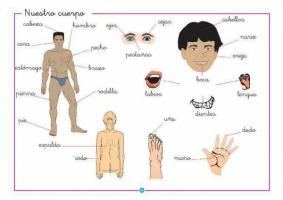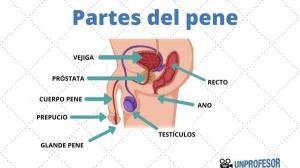Classification of mutations
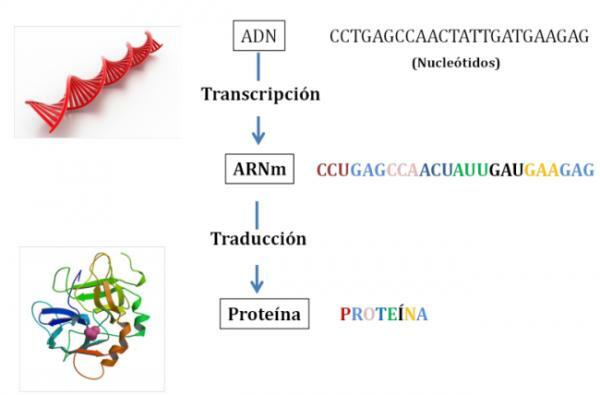
Image: Metabolic Guide - Hospital Sant Joan de Déu
The Genetic information of organisms is "written" in our DNA, in what we call genes. Sometimes the information contained in the genes changes in a stable way and so-called mutations are generated. As we will see in this lesson from a TEACHER, the variations or mutations that genes can have They can be of different types and have different transcendence, in the body of an individual or of a species. If you want to know the classification of genetic mutations and its possible effects, we invite you to continue reading!
To begin with this classification of mutations, we will begin by talking about the selection that is made according to their structural effect. Genetic mutations can be classified according to how the individual's genetic structure is altered into two large groups: alterations in the genetic sequence (called small-scale mutations) or mutations that affect the structure of the chromosomes. If you are not clear about the differences between gene and chromosome you can review our lesson on Chromosome structure.
- Small-scale mutations. Small-scale mutations are alterations that affect the structure of genes or some of the nucleotides that make them up. Within these alterations we can find nucleotide insertions (which can lead to changes in the reading frame), deletions or deletions of nucleotides or substitutions of one nucleotide for another (which, as we will see later, may or may not have effect).
- Large-scale mutations. Alterations that affect the structure or number of chromosomes are called large-scale mutations. Among these types of alterations we find amplifications (such as gene duplication), deletion of large chromosome fragments (of more than one gene), mutations of regions that affect more than one gene and structural rearrangements (rearrangements, non-homologous exchanges, inversions, etc.)

Image: Slideshare
Alterations in genetic information can have different effects at the functional level, that is, it can involve a:
- Loss of function mutation. The alteration produced in the gene produces an inactivation or loss of function, which can be total or partial.
- Gain of function mutation. The altered gene has more expression than its original version and it may either be more affect in its activation or that it is activated in situations in which its original version would not be.
- Negative dominant mutation. The alteration produces a new allele of the gene whose product acts as an antagonist of the original or wild gene product.
- Hypomorphic mutations. In these types of mutations, the alteration produces a lower expression of the gene than the wild version.
- Neomorphic mutations. In this case, the alteration of the gene gives rise to the synthesis of a new protein, different from the one encoded by the wild version.
- Lethal mutations. On other occasions, the alteration of the original gene causes the death of the organism that suffers it and we are facing lethal alterations.
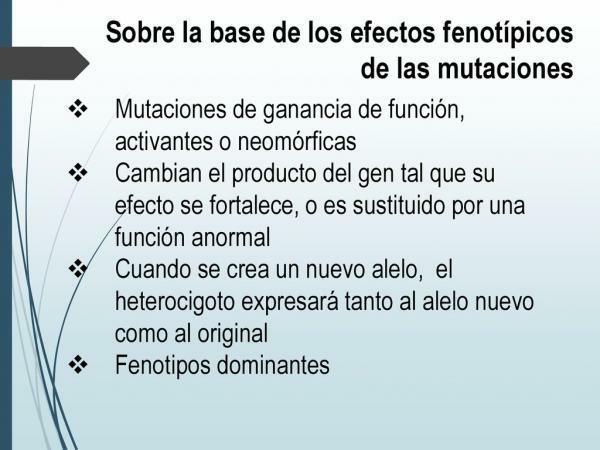
Image: SlidePlayer
Another classification of mutations is depending on the adaptive effect. In applied genetics, it is normal to speak of a mutation according to its adaptive effect, that is, according to whether it is beneficial or not according to the conditions described for that situation. It must be taken into account that the mutations will be beneficial, deleterious, neutral or almost neutral according to the conditions that we are considering and that the same mutation can be beneficial in some conditions but deleterious in others.
- Beneficial mutations. The appearance of beneficial mutations occurs when the alteration of the original gene results in a characteristic (phenotype) that makes the individual who has it better adapted to certain conditions than wild version.
- Deleterious mutations. These types of mutations occur when the alteration of a gene produces a characteristic (phenotype) that makes that individual worse adapted than the organism with the wild version of the gene.
- Neutral mutations. Finally, mutations that do not produce harmful or beneficial effects on the individual's adaptive capacity are called neutral mutations. Neutral mutations are continually occurring in our DNA.

Image: SlidePlayer
DNA alterations can occur in two types of cells, somatic cells or germ cells. The cells of the germ line are those that give rise to the gametes or sex cells and that, therefore, are responsible for transmitting the genetic material to the next generation. Instead, somatic cells are the rest of the cells, those in charge of forming the rest of the individual's body (from neurons to skin or liver cells). Therefore, these mutations will have different meanings for the species:
- Germ line mutations. These cells are responsible for "transporting" the DNA from one generation to another, so alterations in the DNA of these cells will be inherited to the next generation. These types of mutations are the only ones capable of generating changes or effects at the species level since they are capable of leading to the appearance of a new genetic allele or changing the allelic frequency.
- Somatic line mutations. Non-sex cells are called somatic cells. The alterations in this type of cells are not inherited since these modifications do not affect the gametes. This type of mutations "is born and dies with the individual", that is, they occur in an individual but this you cannot pass them on to the next generation (which originates from your gamete).
For example, imagine that there is a base substitution mutation in a cell that generates neurons; This mutation will only affect the neurons that come from that initial cell, and it will not affect the liver cells or the gametes (and therefore, the next generation will not have it). On the other hand, if the mutation occurs in the germ line, it will give rise to an altered gamete (oocyte or sperm) and, therefore, that mutation can be inherited by the next generation.

Image: SlidePlayer
And to finish this lesson on the classification of mutations you should know that they can also be classified according to the impact that they may have in the sequence of the protein to which the gene gives rise. Proteins are made up of units called amino acids, which are the product of the translation and transcription of information from genes three at a time (codons). Mutations in genes can have different effects depending on whether they are:
- Mutations that alter the reading frame. An insertion or deletion of nucleotides generates an offset or change in the reading frame, with which all the reading codons from said alteration change. Imagine that the imaginary DNA strand with the following sequence AGG-TCA-CCA-TTA-GGC-ATC suffers a deletion of the first T giving place with this elimination to a variation in the reading of the same, which will be read as follows: AGG-CAC-CAT-TAG-GCA-TC;
- Point mutations. In other cases, point mutations occur, affecting only one nucleotide. These types of mutations can in turn be: synonymous mutations (the amino acid generated in the altered chain is the same as in the original chain) or non-synonymous, in the altered chain. that the new sequence generates a different amino acid or may result in a premature stop of amino acid placement because the new codon encodes the signal for STOP. In the latter case, proteins are generated, shorter than normal, which are called truncated proteins, which can sometimes perform the same function as the original but with less intensity.
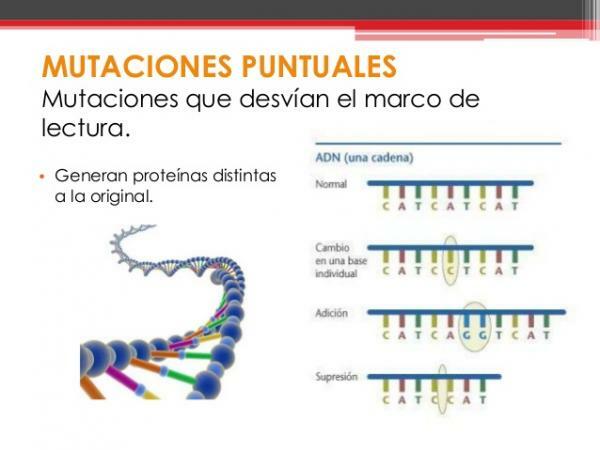
Image: Slideshare


